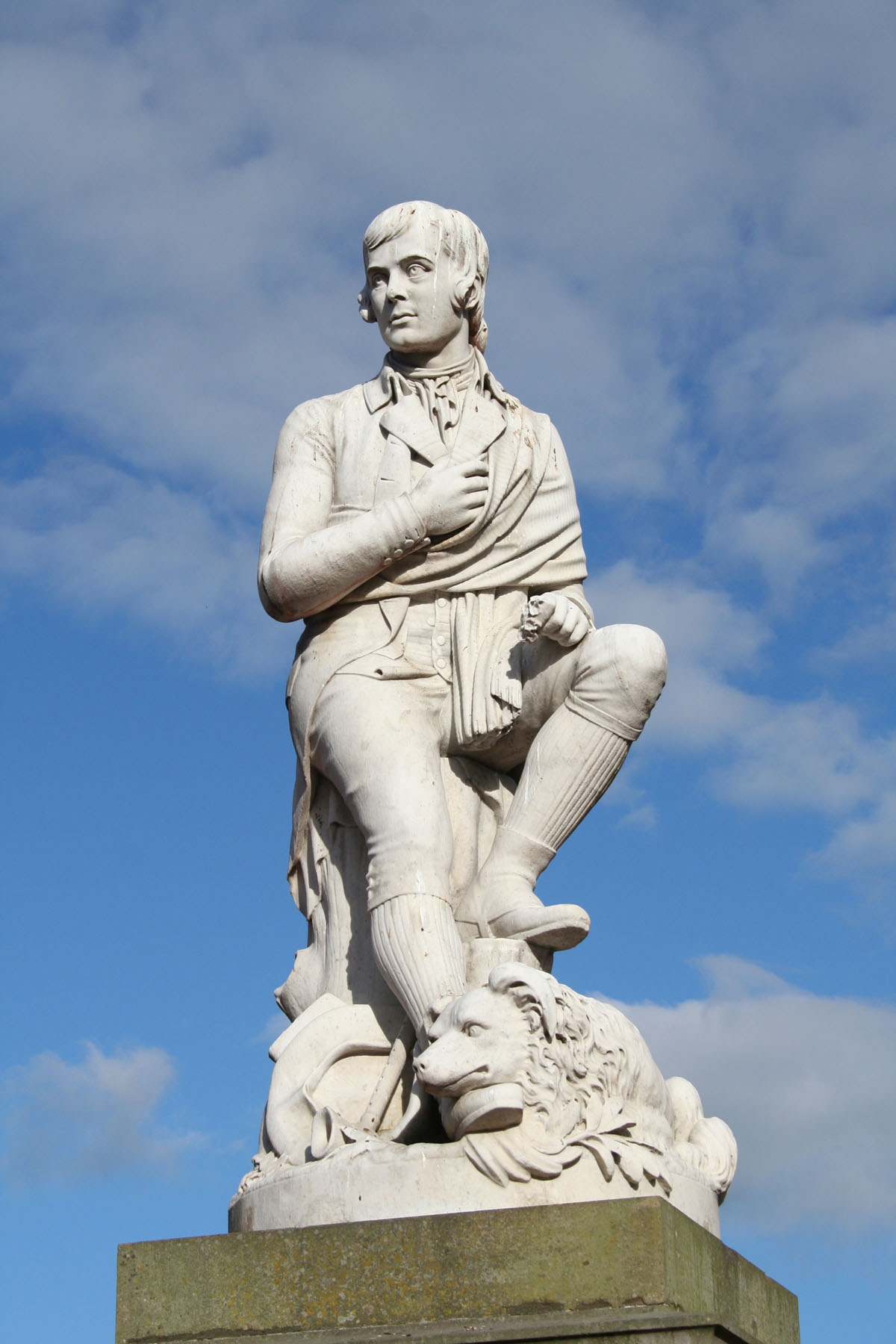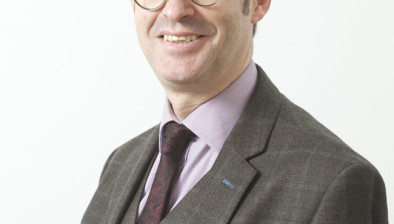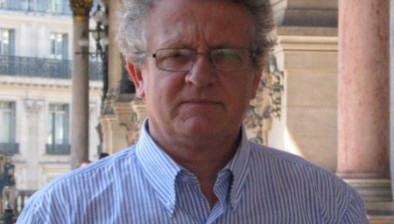David J Black: Robert Burns – the Hollywood sensation that never was

Statue of Burns in Dumfries town centre, unveiled in 1882.
David J Black reminds us just how famous Burns was. See part one here.
This is where your scrivener craves his readers’ indulgence with a minor whimsy, as first set out in The Scottish Daily Mail (a well known paper of record, so it must be true). Burns had a friend and correspondent in Helen Craik, poet and Gothic novelist, whose older half brother, James, had emigrated to Virginia by way of the West Indies around 1750.
A ‘natural’ (i.e. illegitimate) son of landowner William Craik of Arbigland, James Craik graduated as a physician at Edinburgh University. After enlisting in the army he served in the Caribbean as a military doctor, but it would appear that sojourn was a stepping stone, for in 1754 he was living in Norfolk, Virginia, as a surgeon to the Virginia Provincial Regiment under a Lt. Colonel George Washington who had not long returned from the West Indies himself, where he’d travelled with his invalid brother, Lawrence. They became lifelong friends and ‘brothers-in-arms’.
Craik would later be appointed surgeon-general for the Continental Army and the president’s physician. Another Scot with a role in the foundation of the new republic was John Paul Jones, also born at Arbigland estate. His father was supposedly the gardener William Paul, though some suspect that he was another ‘natural’ son of the fecund laird. Thus it would seem the surgeon-general of the Continental Army and the first Admiral of the US Navy were quite possibly half brothers!
Was Burns planning to follow in Craik’s footsteps, with ultimate objective of settling in Virginia with Highland Mary? It’s an intriguing, if unprovable, thought. He would doubtless have been temperamentally better suited to a life in the new American republic, in marked contrast to one of dutiful service on a Jamaican slave plantation, and he was certainly an unstinting admirer of Washington and the revolution. In Nasmyth’s famous portrait Burns’ waistcoat is even in the buff and blue of the American Continental Army while his 1794 Ode for General Washington’s Birthday advanced a shared Scottish-American cause:
But come, ye sons of Liberty,
Columbia’s offspring, brave as free,
In danger’s hour still flaming in the van:
Ye know, and dare maintain, the Royalty of Man.
Thee, Caledonia! thy wild heaths among,
Famed for the martial deed, the heaven-taught song,
To thee, I turn with swimming eyes.
Where is that soul of Freedom fled?
Immingled with the mighty Dead!
Beneath that hallowed turf where Wallace lies!
Scotland’s late 18th century authorities vigorously pursued the sedition laws, and it was no time to express radical views. Some had more leeway than others. Burns was friendly with at least two aristocrats who may well have been supportive of any plans he might have been hatching to find his way to America. One was Lord Daer, the radical oldest son of the Earl of Selkirk (whose silverware had been stolen during John Paul Jones’ daring raid on St Mary’s Isle, near Kirkudbright!) The other was the 11th Earl of Buchan, a determined Scottish patriot, who frequently corresponded with George Washington, whom he termed ‘cousin’.
It is usually assumed this was mere pretension on Buchan’s part, yet the president did indeed have Anglo-Scottish ancestry dating back to Gospatrick, Earl of Northumberland, Dunbar and March (1040 – 1075) who had been granted Royal Arms by his cousin, King Malcolm of Scotland featuring the Lion Rampant. His great, great grandson, Sir William Fitzpatrick de Hertburn (1150 – 1194) took as his second wife the sister of King William the Lion of Scotland, and granddaughter of King David 1st. They were granted the lands of Wessyngton, Tyne and Wear, by the Bishop of Durham, adopting the style ‘De Wessyngton’. The youngest son of their grandson William de Wessyngton III married Joan de Strickland in 1292, and established George Washington’s direct ancestral line. For reasons of geopolitical expediency, the family dropped the Scottish Royal Arms and matriculated another, consisting – would you believe? – of a star and a stripe!
Buchan’s Scottish patriotic fervour involved reclaiming the poet James Thomson as a Scot, although Thomson had left Scotland at the age of 25, and would, ironically, later write the lyrics of the Proms anthem Rule Britannia. Purchasing his family’s former Border estate, Dryburgh, his lordship set about creating a “patriotic landscape” around the ruins of the ancient abbey and planned a “Temple of Caledonian Fame” in which paintings and portrait busts of heroic Scots were to be gloriously displayed. An enormous “guardian” statue of William Wallace was raised on a ridge, and still keeps watch across the River Tweed.
He also commissioned a “Temple of the Muses” on a wooded knoll. In the archives of the New York Historical Society (Gilder Lehrmann collection) there is a letter he wrote to the radical historian Catherine MacAulay Graham in which the purpose of this structure is explained.
It was to be a celebration of revolution as much as a monument to Thomson, paying homage to such figures as the English parliamentarian, John Hampden, George Washington, and Catherine MacAulay Graham herself. Within the encircling nine columns (one for each muse!) was to be a sculpture of Burns, the whole beneath a dome topped by a bust of Thomson over a Roman lyre.
In the event, the war with France made such radical symbolism toxic. Instead of Burns, the interior contained a Coade stone figure of the Apollo Belvedere, now long gone. Only Thomson survives.
Although Buchan’s championing of Burns was not unqualified (he urged him to write in Augustan English, rather than Scots vernacular, for example) it is likely that he would have approved of any transatlantic ambitions the poet might have been entertaining. His lordship’s ‘cousin’ Washington would certainly have welcomed him. Lodge no 4 Fredericksburg, of which he was warden, was well stocked with emigrant Scots who had the works of the poet in their homes, while Washington himself was proud possessor of a copy of Burns’ Poems, Chiefly in the Scottish Dialect. His dining room marble fireplace even had an image of a ploughboy harnessing his horse to the plough, recalling our Heaven taught Ploughman.
Burns remained, and still remains, much revered in America. According to the 1859 Cooper Institute Oration on Burns delivered by the Reverend Henry Ward Beecher, father of the author of Uncle Tom’s Cabin.
“Burns sympathized strongly with both the American and French revolutions[…] At a private dinner, in 1793, when the host proposed the health of William Pitt, the poet said, sharply, ‘Let us drink the health of a greater and better man – George Washington’.”
The following year’s Cooper oration was to be given by another devotee of Burns, Abraham Lincoln. The aspiring president had been schooled in the works of Burns by Jack Kelso, a teacher from Glasgow, and he often quoted from his poetry at will.
Five years later, in an attempted reconciliation speech in the White House, Lincoln recited To a Mouse, from memory, stressing the lines I’m truly sorry man’s dominion/Has broken nature’s social union. After the speech he turned to his secretary, John Hay, instructing him to book a passage to Scotland, where he intended to show his family around Burns’ country.
Days later Lincoln was assassinated by John Wilkes Booth. His widow Mary and their son Tad would make the Scottish pilgrimage in 1869. She is said to have sighed – possibly even wept – before the statue of Burns’ lost love, Highland Mary, in Greenock Cemetery.
Another admirer of Burns was journalist and former slave Frederick Douglass, who spoke in Greenock, among other places in Scotland, with abolitionist William Lloyd Garrison in 1846. He also met Burns’ sister Isabella while visiting his birthplace. His own edition of Burns’ works was inscribed “this book was the first bought by me after my escape from slavery”. He considered him “far more faultless than many who have come down to us in the pages of history as saints” and at no time criticised Burns’ planned voyage to Jamaica. Nor did boxer Muhammad Ali, when he visited Burns birthplace in 1965, having penned his own impromptu doggerel homage.
I’d heard of a man named Burns – supposed to be a poet
But, if he was, how come I didn’t know it?
They told me his work was very, very neat,
So I replied: “But who did he ever beat?”
Burns’ influence on literary America was considerable. Ralph Waldo Emerson and Walt Whitman were admirers, as were Robert Frost, Willa Cather, William Faulkner, Mark Twain, John Steinbeck, J.D Salinger, Maya Angelou, and John Greenleaf Whittier, while Herman Melville distributed books of his poetry as gifts, and Washington Irving claimed him as his favourite poet.
Perhaps the best known link between Burns and popular American music is Bob Dylan’s declaration that the song that has influenced him most is My Love is like a Red, Red Rose, while his great hero Woody Guthrie wrote an imaginary message to Burns, stating “I bought your little four-inch square book when I was a torpedoed seaman walking around over your clods and sods of Glasgow”. In her 70s, Joan Baez, whose mother was Edinburgh-born, regretted not making an album of Burns’ songs in her younger years. Among those who did record Burns’ music were jazz vocalist Maxine Sullivan and big band leader Benny Goodman.
It seems astonishing that the movie industry has largely bypassed this man’s story as a subject for a blockbuster – he’s even provided much of the musical score. Perhaps someone should persuade Lin-Manuel Miranda to produce a Burns follow up to Hamilton!
David J Black’s bestselling book The Secret Scottish History of America is still looking for a publisher.








